Jade River: A History of the Mahurangi
Ronald H LockerFirst published 2001. Published online 2014–. This online edition is a work in progress…
Pages 46–57in printed edition
Gordon Browne and his spar station
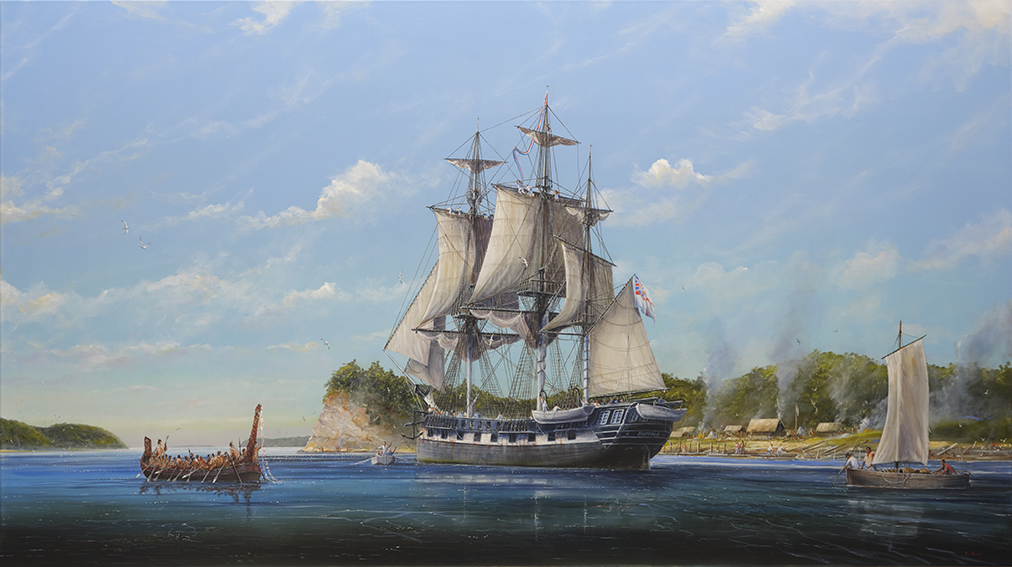
First Pākehā Settlement in Auckland in Mahurangi: Established in 1832, “Mr Brown’s [sic] Establishment”, although abandoned by 1836, was nevertheless the first European settlement in the half-million-hectare Tāmaki Makaurau, now nearing two-million-strong, metropolis. The next sustained industry—boatbuilding—was arguably a more sustainable use of the finite old-growth kauri timber so keenly sort for spars by Royal Navy, embodied by the hmss Buffalo, which anchored two and half cables down harbour from where she is shown here. Commissioned by Mahurangi Action and friends, this is the only known depiction of the region’s first Pākehā settlement, and Pākehā-built vessel—the spar station workboat shown here astern the Buffalo. marine artist Paul Deacon
Gordon Davis Browne was both the first recorded timberman and the first Pākehā Mahurangi Harbour resident, and indeed of Tāmaki Makaurauas published 2001: white resident on the Mahurangi , although he stayed for only four years1832–1836.
His credits extend far beyond the bounds of Mahurangi—from his pioneer timber station of 1826 in the Hokianga Harbour, to the first sawmill in the country at Mercury Bay in 1838. Dr S V Martin said of him in 1839 that he:
…is in a great measure entitled to the credit of having established the timber trade of New Zealand.
Since no account of his adventurous life in the colonies has been published, his story, entwined with that his associate Dacre, is presented here as fully as my gleanings of the records allow.
A misleading notion of Browne’s origins came from a crewman of hms Buffalo, who erroneously described him as ‘a Scotchman’Gordon Browne was not a ‘Scotchman’ as recorded by Hodgskin (1841), but English and of Huguenot ancestry. Born in or about 1805, Browne was one of 15 children (10 sons and 5 daughters) of Catherine and William Loder Browne of Lambeth, near London.. Since Browne’s brother was an officer in the Indian Army, it is likely that he came from a middle- or upper-class family. He first emerges as manager of a ‘New Zealand trading wharf’ in Sydney, probably that of the prominent Sydney merchants, Raine and Ramsay, on whose behalf he set sail in 1826 for the Hokianga. Captain Thomas Raine had come to Sydney in 1814 as an officer of the convict transport Surrey, arriving in command after his seniors had succumbed to typhus. Ramsay was a physician. The partners, backed by the Bank of New South Wales, were general merchants and shipowners. Amongst their trading interests were Tahitian timber, pork and coconuts, sugar from Mauritius, and the first shipment of Australian cedar to England in 1827.
By November 1826, Browne had purchased land in the Hokianga at Horeke, and established saw pits, a timber yard, a trading depot, and a shipbuilding yard, superintended by Captain David Clark. The Sydney Gazette in May 1827 noted that:
A branch of commerce has been entered into by Messrs Raine and Ramsay. The speculation consists of an extension of the trade with New Zealand. A cargo of produce was brought up the other day in the barque Faith, consisting of spars, fine deal planks, and forty tons of flax…
and three weeks later:
…about fifty Englishmen from this port are at Hokianga, sawing deals and instructing the natives in shipbuilding.
In 1828, the first schooner, the Enterprise, was launched at Horeke—it was wrecked on the Hokianga Bar the same year; the crew were all murdered. The artist, Augustus Earle, who painted the scene at Horeke, The Deptford Dockyard, wrote:
I was greatly delighted with the appearance of order, bustle and industry it presented. Here were storehouses, dwelling-houses and various offices for the mechanics—
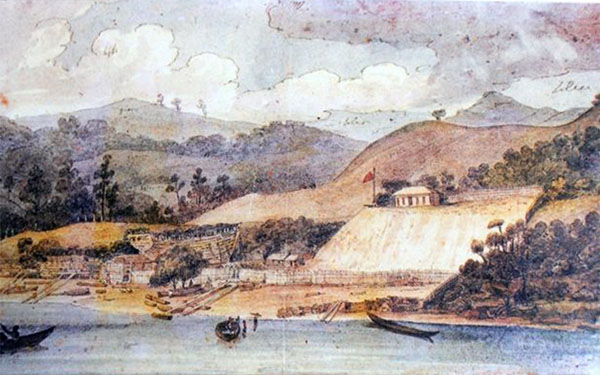
Dead Before Forty: Not only was the Auckland region’s first European settlement short-lived, so, was its founder Gordon Browne, who was baptized 22 March 1805, and buried 28 January 1844. At the time it was painted, Browne managed the grandly named Deptford Dockyard at Horeke depicted in this 1828 Augustus Earle watercolour. image Radio New Zealand | Augustus Earle
He noted another vessel of 150 tons on the stocks.
The station acquired neighbours, when in 1828, the Wesleyans set up a mission at Māngungu, a mile downstream. The missionaries complained that the employees at Horeke were a bad influence on their flock, frowning on the drunken brawling and frolics with young Māori women. A letter arrived from Sydney for Clark, instructing him to maintain conduct:
…regular and orderly as possible [by] limiting the issue of spirits [and requiring] a strict observance of the Sabbath.
Ramsay withdrew from the partnership in October 1828, alarmed at ambitious plans and suspicious about the accounts. Raine was declared bankrupt two months later, but his creditors allowed him to continue trading. It has been said that Browne was his partner, but it appears that he was only a manager. A letter from Thomas Raine to the Colonial Secretary (3 January 1829) shows that work at Horeke was still in full swing. He complained of difficulty in registering the two ships already launched at his two-year-old establishment at ‘E.O.Kianga’, but says that he is building another, and is actively engaged in the flax and spar trade. (He makes no mention of a partner). When the second ship arrived in Sydney, loaded with flax and timber, after a smart passage of six days, the Sydney Gazette said:
The establishment belonging to Capt. Raine at New Zealand, under the immediate direction of Mr Gordon Browne, is going on most auspiciously. The New Zealander, a brigantine, and one of the prettiest vessels of her class that have ever entered our harbour, was built at Captain Raine’s establishment. Her figurehead is that of a New Zealander, and she imports one of the choicest cargoes of timber ever forwarded from that original cannibalic Elysium.
Planks from Horeke sold in Sydney at £1 per 100 specific feet, and gargantuan ‘pine’ oars (10–30 feet) at 9d per foot.
Work did not always go on at the yard as smoothly as Earle observed. Henry Williams’ journal of 8 April 1829, notes:
…much disturbance between Mr Brown and his men. Some nearly shot.
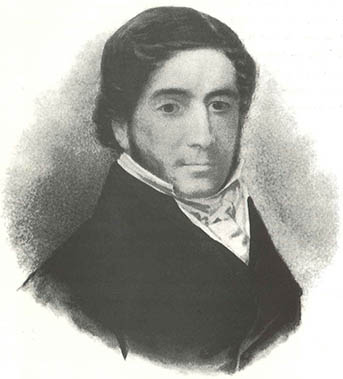
Sydney-Based Boss: From 1826 to 1830, Gordon Browne worked for Captain Thomas Raine, of the Sydney general merchants, shipowners and agents Raine and Ramsay. Their establishment in Horeke bore the ill-fated schooner Enterprise, which was promptly lost on the Hokianga Bar; all crew murdered. image Afloat Magazine
Unfortunately, Raine did not manage to trade his way out of debt; his creditors foreclosed in 1830. Although the Horeke enterprise was viable, the bankers had become nervous during a slump, and called in their debts. Since 1825, coastal and inland New South Wales had suffered consecutive years of severe drought with failure of crops and pasture. Raine, with wide pastoral interests, was affected. In January 1830, at a Sydney auction, Thomas McDonnell bought the Horeke station and its third ship, the Sir George Murray, then lying in Port Jackson. He embarked his family and launched on a new career in New Zealand.
Browne, now redundant, remained in Sydney. About this time, he entered the employ of a Mr Mossman, apparently a flax trader. Flax was then in great demand for sailcloth as well as rope.
A cluster of documents survives, relating to a court hearing of 1831 in Sydney on the notorious affair of the brig Elizabeth. The captain, John Stewart, had just landed there an ill-gotten cargo. He had done a deal with Te Rauparaha: in return for a cargo of flax, he had taken a war party to Akaroa, where the inhabitants were massacred, the captain apparently conniving in the treachery and brutality. It may have been Browne who received the cargo of flax. Hearing the tales around the wharves, he was moved to take the initiative towards justice—Māori he saw as friends, and he was fluent in their language. Governor Darling wrote afterwards to the Secretary of State (14 April 1831):
A Mr Gordon Browne who resided for some time in New Zealand and who intends to return thither, first brought this matter to my attention—a recent occasion has induced Mr Browne to again draw my attention to the subject.
At the hearing, Browne swore an affidavit (5 February) on the information he had gathered. He was also interpreter for the deposition of a Māori witness, nephew of the murdered chief. (Both affidavit and deposition give his full name as Gordon Davies Browne; his Mahurangi land claim as Gordon Davis Browne. I assume the former to be correctDr Ronald H Locker’s assumption was reasonable but incorrect—Davis is the correct rendering). In the end justice was not done. The Attorney-General was devious. Stewart jumped bail, was seen in the Hokianga, then vanished with his ship into the Pacific.
Browne’s affidavit confirms his presence in Sydney early in 1831 and his imminent return to New Zealand, probably to seek flax for Mossman. The arrival is confirmed by the diary of Henry Williams, who on a visit to Whangārei Harbour, had an unexpected visitor:
Mr G D Brown, a young man of considerable respectability, formerly a merchant in Sydney, but now residing here for the purpose of procuring flax, called on us and represented his precarious position. Tendered our services as far as respected his private property, but that muskets, powder etc. etc. must run their chance.
Mr Browne came and spent the afternoon. Complained bitterly of the delay of the natives. He would gladly pass on in his boat but the natives will not let him pass.
This encounter took place on Limestone Island. Browne was feeling very insecure in his savage company, and frustrated that Māori would neither deliver the flax, nor let him leave, wanting those muskets badly. Williams obviously disapproved of such barter; indeed he spent half his time trying to stop tribal wars. It should be remembered that the whole of Browne’s New Zealand experience was set in traumatic times for Ngāpuhi. Hongi died while Browne was at Horeke, but his musket wars continued for a decade, and his legacy of desolation lasted much longer. The Tamaki had been laid waste. While Browne was at Mahurangi, Ngāpuhi were still raiding to the Bay of Plenty and beyond. Everywhere the tribes were on edge, and eager to purchase guns of their own. The north was a precarious stage for those Pākehā who ventured to move among the natives in pursuit of trade.
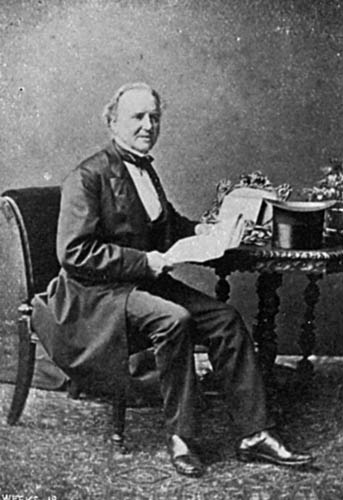
Crucial Admiralty Connections: Captain Ranulph Dacre’s dealings with Robert Brooks of Robert Brooks and Co., London, with Brooks’ lucrative contracts with the Admiralty led to the establishment of the Auckland region’s first Pākehā settlement, Brownes Bay, named for Gordon Davis Browne, its founder. Farther south, at Karepiro Bay, Dacre Cottage was named for Captain Dacre, pictured, who, in addition to Weiti Station, held 4000 acres at Ōmaha. image Warkworth & District Museum
Luck did not smile on Browne. His flax trading venture ended in disaster. He arrived back in Sydney destitute, three months later (2 May). He was promptly offered a job by Captain Dacre, who later claimed to have rescued Browne when he arrived with the Guide:
…with barely sufficient clothes to cover him, having been burned out at the Thames.
His new employer, Ranulph Dacre, was a courageous adventurer and an irrepressible entrepreneur, who enjoyed a reputation as a gentleman and square-dealer. In many ways he resembled William C Daldy. Son of the high sheriff of Hampshire, he joined the navy in 1810, but resigned in 1816 to become a wandering master mariner, in the service of Robert Brooks, shipowner and trader of London. Dacre was still working for him in 1832. The ships Bolina, Surrey and Nancy, which appear in the following story under Dacre and other masters, were all Brooks’ ships and made periodic voyages back to London. Brooks had negotiated a contract to supply the Admiralty with spars, under a bond of £10 000. Dacre received a letter from London in August 1831, instructing him to supply.
Dacre’s correspondence in this period is preserved in the Mitchell Library, Sydney (R Dacre. Letter Book 1831–2). The gist of its content is unexpectedly available, with other valuable information, in The Riddle of the Kaipara by T R Byrne, 1986. Written to dispel the myth that Dacre was the first to enter the Kaipara, it provides a scholarly chronology of Dacre’s movements, which has been crucial in ordering the fragments on Browne, gathered here.
Dacre had first met Browne when, on 20 April 1829, he sailed the barque Surrey in over the Hokianga bar, under instructions from a charterer to deliver an order to Gordon D Browne:
…who will render you every assistance in the loading and despatching of your ship.
The charterer was Raines, who was attempting to set up a packet service to England; the ship, a convict transport, had been his first command. It sailed on 28 September with spars, flax and potatoes. At this first meeting, Dacre had plenty of time to get to know and appreciate Browne, and to grasp that in this trade there was no substitute for local experience and fluency in te reo Māori.
Dacre busied himself implementing his principal’s instructions of August 1831. The next month he married Margaret Sea, who accompanied him on some of his subsequent voyages. He was frustrated at not being able to obtain the services of Browne, then in Mossman’s employ, but purchased a schooner and despatched it under Captain James Skelton with six men, to New Zealand. Dacre wrote:
…there are at least 50 stations now occupied at those Islands.
Skelton already knew Mangonui, and headed there. Land was bought and a house built, but the trees proved too short for spars. In January 1832, Skelton shifted to Mercury Bay where the trees were fine, but, as Dacre told the Land Court in 1862:
A few days after landing the carpenters, the schooner was wrecked and a wild tribe from the Thames came across, and drove the carpenters and crew away, setting fire to their houses and store, by which a loss of £1200 was sustained.
All hands were rescued under fire, by the timely arrival of the Guide.
![Go to National Library of New Zealand: Heaphy, Charles 1820–1881, ‘View of the Kahu-Kahu Hokianga River’ [December] 1839 The Bolina, left, and the Francis Spaight](https://www.mahurangi.org.nz/wp/wp-content/uploads/2017/05/Bolina-Francis-Spaight-600.jpg)
Round Squared for Square Hole: Ironically, logs destined to be masts were first roughly squared for compact and secure shipping, before being further pared down to their final, round, section. The ship astern of the Francis Spaight, being loaded by her bow ports, is the Bolina, which took Browne and Dacre to Mahurangi, in 1832. The scene depicted here is Kohukohu, Hokianga Harbour, 1839. artist Charles Heaphy
Dacre was getting desperate, but two events served to cheer him up. He had finally been able to engage Browne, just returned from New Zealand. (It seems possible that Browne, making no progress at Whangarei, had been recruited by Skelton for the Mercury Bay venture, since Browne arrived back in Sydney on the Guide’s first return voyage after rescuing the team at Mercury Bay. This would account for Dacre’s claim that Browne had been burnt out at the Thames and their meeting on his arrival back). Dacre was clearly delighted at gaining the benefit of Browne’s experience. Then, on 26 March, Brook’s 243-ton brig Bolina arrived in Sydney from London. Dacre advised Brooks:
The schooner is lost and I shall go down [to New Zealand] in Bolina… [and that I will] try a River near Point Rodney in the River Thames. [I have agreed with Browne to procure] 115 masts and 500 loads of timber for the sum of £750, this sum includes every expense—I do not think he will make more than £200 out of it. [I expect] to be absent 4 to 5 months as I cannot leave Browne and his men till they are comfortably settled, it will take him 12 months to complete this contract.
Browne had taken on Joseph Kendall as a partner, a son of Thomas KendallDr Ronald Locker referred here to Joseph Kendall as Mr I Kendall, the former missionary, who had become a timber trader in New South Wales. Dacre warned of the:
…difficulty in procuring now in New Zealand as the War is all over the Island [but expected] much assistance from Mr Browne as his knowledge of the New Zealanders is so great.
So, on 7 May 1832, the Bolina left Sydney under Captain Murdoch, with Dacre, Browne and Kendall, and eight carpenters and sawyers, arriving in the Mahurangi Harbour on 21 May. The station was set up on a purchase of 5000 acres. A visit was made to Mercury Bay, hoping to retrieve timber felled before the skirmish, but Dacre judged that he could not:
…venture to take it away as the parties are now at war and it would not be safe.
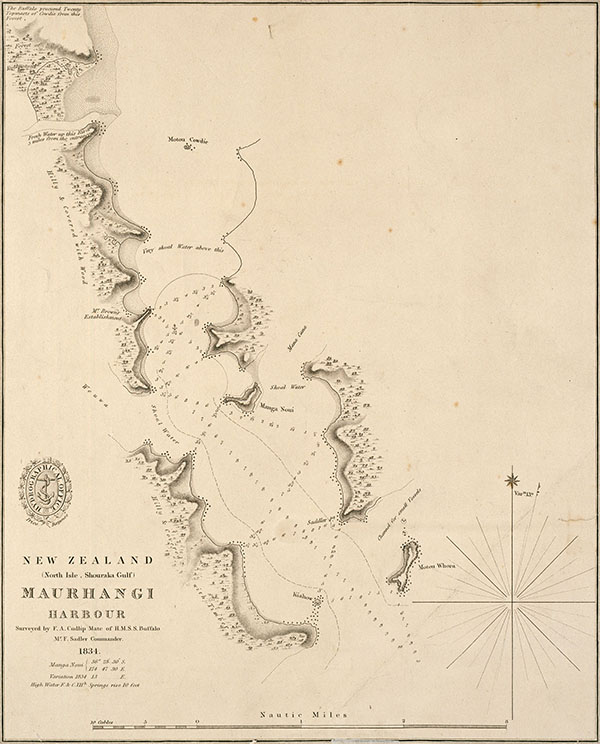
Mr Browne’s Establishment: Labelled by first mate Frank Cudlip as Mr Brown-without-an-e’s establishment, what should probably be called Gordon Browne Bay, including to avoid confusion with populous Browns Bay, is shown on this first chart of the Mahurangi Harbour at the limit of navigation for the likes of the hm storeship Buffalo, on the western shore. chart Auckland Libraries
Instead he resolved to take a cargo of spars back to Australia from the Hokianga. In June the Bolina left Mahurangi, taking Browne to assist on his old ground, and leaving Kendall in charge. (Kendall is never mentioned again). On 12 July she ran in over the Hokianga bar, and that afternoon, Browne and Dacre took tea ashore with Reverend and Mrs White. Their estimate of 14 days to load was optimistic. On 19 August Dacre left his ship loading for Hobart, farewelled Browne, and sailed for Sydney in Lord Liverpool. Browne, it seems, walked over to the Bay, where Henry Williams recorded that he turned up at Sunday service in Paihia on 25 August. During the next two weeks, he enjoyed the company of the missionary, to whom he brought news of the sad state of the natives in the south: “few in number and decreasing from war and sickness”. Browne must have then found a ship willing to drop him back in the Mahurangi Harbour.
Dacre referred to the founding of the Mahurangi station in his evidence to the New Zealand Court of Land Claims in 1862. He said:
In May 1832, I left Sydney in Bolina taking with me G D Browne and 15 other men to form a spar station. We landed at Mahurangi and there commenced squaring spars and preparing masts. We bought a tract of land and had it surveyed by Mr Florance.
On 24 December 1840, Browne submitted to the Colonial Secretary, New South Wales, a document containing five land claims, all in his name alone, in the prescribed format for pre-Treaty of Waitangi claims, to be heard by the newly appointed commissioners. The document, apparently in the handwriting of a law clerk, is in the name of Gordon Davis Browne, at KororarikaKororāreka, later renamed Russell. Claim No.1 concerns Mahurangi; Nos.2-4, Mercury Bay; No.5, land at the Tamaki. The manuscript has been altered, almost certainly by Dacre, who prepared the claims for a hearing in New Zealand in 1841, Browne, by then, being dead or incapacitated.
Claim No.1 for Mahurangi concludes:
…the particulars of the transaction cannot be more fully set forth as the writings are lost or mislaid…
Similar riders apply to the others. Florance’s map, if it existed, is lost. The land was bought from Puhata, William Pepena and others, chiefs of Ngāti Pāoa. It seems Mahurangi was sold both in 1832 and in 1841 by this tribe over the heads of the fugitive local people. The purchase, for an undisclosed consideration, occurred ‘many years since’ (altered to May 1832), and is delineated by the vaguest of boundaries:
At Mahurangi in the Firth of Thames, a piece of land called MuriotararikiMuriotarariki is today Te Muri bounded on front by the sea, on one side by the river Waipe on the other side by Matanga and at the back by land belonging to the natives – 5000 acres.
The claim was presented to the commissioners in New Zealand (Case No. 76, Gazette, 1841). The price was recalled as £70 in goods.
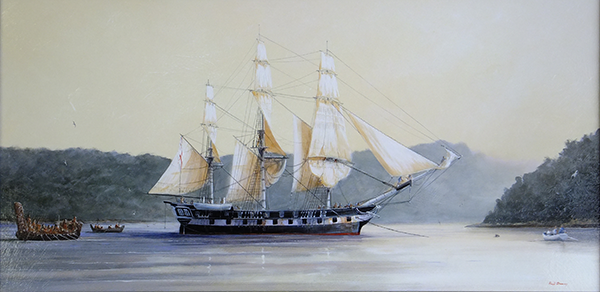
Cutting Out the Middleman: Gordon Browne’s kauri extraction operation supplying spars to the Admiralty was entirely promising until hm supplyship Buffalo, not only helped herself to the resource, but allegedly so enriched the Māori workers that they were disinclined to work for Browne further. The Brown–Dacre operation was moved to Mercury Bay, where, ironically, six years later, the Buffalo lay down her life in, and for, Buffalo Beach. The Buffalo is depicted here exactly in her Mahurangi anchorage, met by Ngāti Pāoa waka. marine artist Paul Deacon
So large an area must have included the catchments of Te Muri, the Pukapuka, and the western Mahurangi Harbour frontage, including Browne’s camp, and extending at least as far as Cowans Bay (since Browne later laid claim to timber cut for the Buffalo at Bradleys Point). The claim failed, and the land became part of the Crown’s Mahurangi Purchase of 1841.
This land claim appears to be the first, largest, and only surviving claim at Mahurangi, although Felton Mathew hints at others. The surveyor, Thomas Florance, was one of the earliest to work in New Zealand. He surveyed widely over the province, from North Cape to Coromandel. He worked for Busby, bought land at Whangaroa, and finally settled at Ararimu, near Riverhead. His records survive in Sydney.
On 3 April 1833, Henry Williams made his first call at Mahurangi. His diary indicates that work had just commenced, and went ahead nicely. Dacre was still there. Browne had settled down with his Māori wife, Jess (also his storekeeper), his white sawyers, and Māori workers, about thirty in all. Browne’s land claim No. 5 above is the most intriguing of all, for it throws the only light on Jess. The 3000 acres, bounded by the Tamaki, the Waipuna Creek and a sandbank, were claimed as a gift of ‘several years ago’, by the same chiefs who appear on the Mahurangi claim:
…to the said Gordon Davis Browne in trust for his child (now living) the mother of the Child being a native of New Zealand and a relative of the above-named Chiefs.
This relationship, and the size of the gift, suggest that Jess had rank, and that the child was a son. Browne may have descendants alive today in New Zealand. Ngāti Pāoa, to which she clearly belonged, owned land on the Western Firth, up to the Tamaki. She would have come to Mahurangi with her kin when they came for the shark fishing, and sometimes to haul timber for Browne. The child would have been born at Mahurangi, probably the first with Pākehā blood. It is interesting that Dacre added his own name to this claim, presumably perceiving that 3000 acres at Tamaki was much more valuable in 1841 than when gifted.
A figure who appears in Browne’s letters is Millon, who, with ‘his man’ and boat, seems to have been a subcontractor of some kind. Thomas James Millon and James Skelton (the captain of Dacre’s lost schooner) made a land claim of 15 000 acres, purchased at Matakana in 1839 (OLC 169). They were granted 1270 acres. Millon became a well-known settler at what is now called Mellins Bay, just east of the Matakana entrance. Millon was apparently a shipwright, since he and Skelton built a ship, The Governor Hobson, together in Coromandel Harbour in 1840.
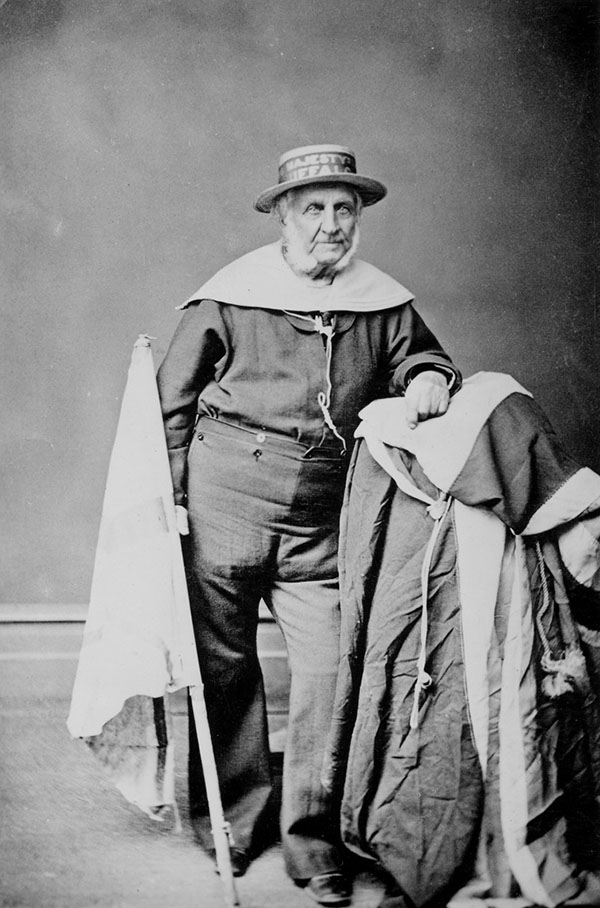
Buffalo Hill: Thanks to her starring role in the proclamation of the Province of South Australia, on 28 December 1836, hm storeship Buffalo’s bo’s’n John Hill, who had ceremonially raised the Union Jack, became the event’s poster boy. Artist Charles Hill’s cloying 20-year-hence rendition of the scene adds to the bo’s’n’s indignity by portraying him making a meal of his proclamation-day duty. And then there’s the restaurant, opened 2001, built somewhat in the likeness of the Buffalo, beside the Patawalonga River at Glenelg, near the location of the proclamation. image State Library of South Australia
Browne’s ménage became an obligatory stop for the missionaries on their frequent journeys to the Thames. Williams found Dacre there in the Nancy on 3 April 1833. This ship of 380 tons had arrived in Sydney on 18 November 1832. Dacre resolved to fill her with kauri from Mahurangi. It was a chance to inspect his station, and to take his new wife on a jaunt. They sailed from Sydney on 15 December. It proved a long stay, until September, and was marred by the death of the ship’s captain, crushed by a spar during loading. Pulham observed that this was the first European funeral on the Mahurangi. The Surrey under Captain Veale, also collecting timber on the coast, picked up the Dacres. In October it sailed for Sydney with a cargo of 196 loads of timber, 187 loads of masts, and the Dacres as passengers. At the Bay they met Williams, and told him of a savage incident during their stay. His diary reads:
Mr Busby and I went on board Surrey to learn news of the Thames. One of Mr Brown’s boat’s crew had been killed at one of the settlements in the Thames.
The entry continued, making it clear that it was no fault of the victim, but a case of tribal utu. Another account of the incident tells that Dacre (and Browne?) had travelled in an open boat from Mahurangi to Coromandel, to get supplies for the men. At the moment of landing, a chief brained one of the crew. At Dacre’s vigorous protest, the chief confessed his error, and offered to kill one of his slaves to balance the account, an offer indignantly declined.
In February 1834 Dacre took William Wilks as partner. As merchants and shipping agents they maintained the profitable links with Brooks in London. Dacre extended his interests to the Islands and prospered, becoming a prominent citizen of Sydney. He was not often seen in Mahurangi again, and business between him and Browne was carried on by letter. Fortunately Browne’s letters1835–8 survive as appendages to the land claims presented by Dacre. They give a picture of the trials of running such an enterprise, and a few tantalising glimpses of the man himself.
Williams tells that in 1834, Browne had a visit from his brother, an ex-officer in the Indian Army. A pious man, formerly on the Madras committee of the Church Missionary Society (see above), he wished to start a school for Māori, but lacked the means.
The enterprise at Mahurangi suffered a setback in January 1834, when hm storeship Buffalo sailed into the Mahurangi Harbour. In 1820, hm storeships Dromedary and Coromandel had brought back to England trial shipments of kauri topmasts. Since then the Admiralty had been eager for more. The Buffalo was despatched with a shipment of female convicts to Port Jackson, New South Wales and arrived off Kororāreka in November 1833. A stay of six weeks at Whangaroa failed to produce any spars. Henry Williams made a special trip there with Ngāpuhi chief Titore to resolve the problem. On 2 January 1834, he wrote:
Detained for a long time in consultation with the Captain and Titore as to the best steps to take. Concluded to move the ship to Mahurangi in the Thames, where Mr G D Brown is.
The latter would not have been pleased to learn that his friend Williams had brought this unwelcome visitation upon him. Dacre later told the Land Court that Captain Sadler:
…took forcible possession of the standing trees, placing the broad arrow on them.
Titore had accompanied the ship, and persuaded local Māori to work the timber. The following year Browne complained in a letter to Dacre:
Our natives were so enriched and spoiled by Buffalo last year that they positively refuse to work, and while I have spars in my own neighbourhood I am obliged to go to other parts for them, and where labour is available.
Dacre himself complained:
I remonstrated with the Admiralty but never got any redress. In consequence of this I judged it necessary to remove the station—to send Mr Browne to take possession of my old station at Mercury Bay.
While waiting for the spars to be delivered, the mate of the Buffalo, Cudlip, used his skill as a hydrographer to make the first chart of the Mahurangi Harbour. It was well done, with numerous soundings. Cudlip was accompanied in his survey by Reverend William Yate, who after seven years of service to the mission was returning to England as a passenger. He wrote the first description of the Mahurangi Harbour, a virtual pilot book.
A more engaging account of the visit came from 26-year-old Richard Hodgskin, the purser’s steward. Well educated and a keen observer, he sent home letters full of detail. Their survival is fortunate indeed, since they are real treasure. His descriptions are here presented in abridged form:
Towards the end of Jan (thermometer 72–79) we anchored in a lonely and romantic harbour called Ki-ya-hou at the head of the Bay of Mourangee or MahrangaMahurangi on the western side of the firth of Thames. The anchorage is secure for vessels of any size, quite as good as the Bay of Islands, for while lying here it blew as heavy a gale as ever was remembered in NZ, and some might be called hurricanes, but we rode it out in safety. The prevailing winds are westerly, but the gales generally blow from the eastward. The harbour can be entered without difficulty, and is infinitely superior to Wangarooa or Hokeanga. There is an extensive forest at its head, and a small river navigable only for boats. Two other rivers, the PohoePūhoi and Wai werri-WerriWaiwera also empty themselves into the bay. The latter signifies hot water, on account of several boiling springs. The temperature will cook fish, potatoes &c, which I have tasted without perceiving anything disagreeable.
I am no geologist, but have reason to suppose useful minerals will soon be discovered adjacent to this place, for I purchased from a native some small pieces of metal ore, very heavy, silvery white pebbles; but I lost them. I have also often picked up lumps of lava, which indicate volcanic action, but I cannot say whether there is any mountain still burning; the natives say there are some in the interior of the country.
The only Europeans we found residing here was a Scotchman, named Browne, and four or five sawyers, employed by him in collecting masts and sawing plank, which find a ready sale in Sydney. Much has been said about the treacherous nature of the New Zealanders, but here are six of our countrymen, shut off from the civilised world, except for a few trading vessels putting in for flax and potatoes, living in security on the most friendly terms with the natives. On my asking a man, six years among them, whether he was afraid, his answer was that there was no fear of injury as long as you acted kind and honourable and did not interfere with their customs or rights. This part of the country was thinly inhabited; but numerous natives from neighbouring tribes, resort here in fishing seasons to catch and dry fish, and procure oil from the livers. The skin of the stingray serves as a bladder for the oil. I purchased several gallons for the ship and found it burn remarkably well.
The natives here excel those of the Bay in making their fishing gear, and also in making mats. Whether the flax was better in quality, or more pains taken in preparing it, I cannot say, but the mats were whiter, more soft and silky, and closer and finer in workmanship. I have one, of rather inferior sort compared with some made in NZ, but I set much value on it because I superintended the making of it. The process is simple – the only instruments I observed being some curious shaped wooden combs, and it is bleached in the sun.
I give you some extracts from my journal to show the friendly disposition of the natives, and the confidence we reposed in them:
The commander returned from examining the forests at the head and directed 90 men to go on shore to fell timber.
The men were divided into three parties, 20 to the PohoePūhoi River, 20 to the Wai Werri-WerriWaiwera, and 20 to the head of this harbour; each party was attended by natives in canoes, who sang songs and assisted our men to carry their provisions and traps from the boats to huts built and thatched with rushes for our reception. They were kind in the extreme.
Fine. Divine service by our commander. In the afternoon, I went ashore to the settlement where Mr Browne and his men resided; they treated me with much kindness; they were all neat, clean and well dressed; everything was quiet, even the natives were not engaged in their ordinary pursuits. After refreshments I went a few miles into the country; passed some plantations of Indian corn, ripe, and potatoes and coomeraskūmara; the men had small plots for gardens; they said it took two years before a good crop on account of the fern roots being so closely matted.
Visited the forest at the head of the harbour. Found 80–90 natives dragging a 72 feet22-metre spar through a deep ravine on small trees laid across the bottom—blue jackets superintending. The natives, singing and working cheerfully, got the spar to the water before dark.
Several fine canoes came in. They had left this place a few days ago for the River Thames for provisions. Two came alongside with pigs, potatoes, and dried fish.
Received six beautiful spars from the Ki-ya-hou forest, for which the chiefs were paid the stipulated barter. They however wanted blankets in lieu of the musket and bayonet. Several of our men purchased musket, bayonet and cartouch-box for a half-worn blanket.
Several strange canoes came in, and in the afternoon Tommy Poor Knight and chief CapangaKupenga brought four spars alongside. About 30 natives slept on board.
A good supply of fish and melons were brought on board; but the natives would take nothing but biscuit in exchange—
The chiefs having been paid for the spars, a new system of barter commenced—the natives bringing on board small parcels of tobacco, and nothing would satisfy them but ‘booka, booka’. In a few hours books became scarce, chests were ransacked, shelves overhauled; books valuable and useless alike vanished and no doubt were soon converted to cartridge paper. Then demand became general for blacking and brushes, our marines monopolising the trade for Jack rarely bothers his brains about shoe-brushes; pots were scraped, the cook’s funnel swept better than it had ever been; every fraudulent mean was adopted to imitate or adulterate blacking. The natives wanted to appear smart – to polish the belts and cartouch-boxes given them for the spars.
A few days before departure from Marangi, a large war canoe came alongside, in which was an Englishman—a stout muscular fellow with his face tattooed, and looking in every respect as ferocious as the New Zealander, and scarcely a shade lighter in complexion. He did not remain long on board, and I was afterwards informed by a native that he was a runaway convict from Port Jackson.
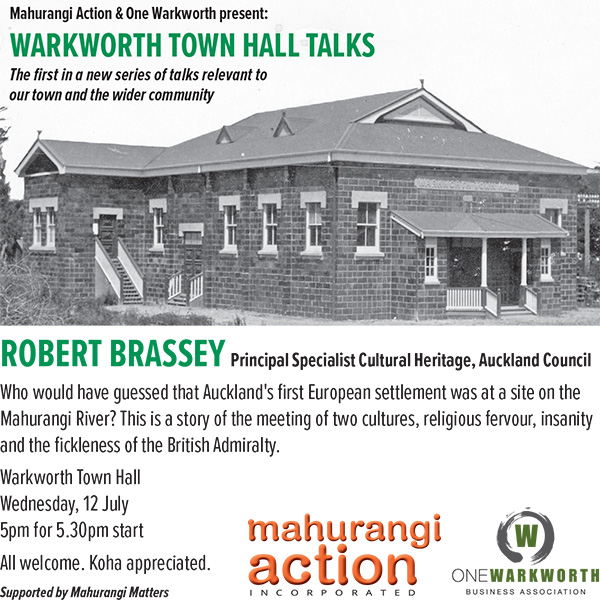
Warkworth Town Hall Talk: Thwarted by atrocious weather and a State Highway 1 closure, a number of Mahurangi residents missed out on Robert Brassey’s Archaeology Week lecture on the Auckland region’s first European settlement, at Mahurangi’s Gordon Browne Bay. The ill wind has brought considerable good, in the form of a command performance, as the first-booked Warkworth Town Hall Talk, on 12 July 2017 at 5 for 5.30 pm. notice Mahurangi Matters
Hodgskin’s account is interesting in several respects. Browne’s establishment has shrunk from fifteen to six Europeans—it rose to thirty by 1836. The Buffalo appears to have drawn on the valleys of the Waiwera and the Pūhoi, as well as the Mahurangi Harbour. The preference for blankets over muskets is surprising, especially as cartridge paper was in demand, but Ngāti Pāoa had by then made peace with Ngāpuhi. Back in England, Yate, in a report to the Society for the Protection of Aborigines, was critical of Sadler’s payment for spars in muskets, bayonets, powder and shot. The well-established cultivations, a few miles inland, suggest remnants of the original tribes of Mahurangi still in residence, beside the commuting Ngāti Pāoa, who provided the timber-hauling force. The cultivation of fernland, indicates long-standing agriculture. It is most likely to have been on the easy land sloping to the south bank of Dyers Creek, on, or above the McElroy property. There is a small but strong pā in the u-bend of the stream above the waterfall at the head of Dyers Creek. It would have provided a good refuge in those troubled times, with a convenient waka access.
When the spars were finally delivered into the tide, the derrick was rigged over the Buffalo’s two stern ports and the timber inserted into the hull and secured for the long voyage home. Hodgskin wound up the visit thus:
Having taken in all our spars, we weighed anchor, and sailed with a favourable wind for Wangaroa, where we arrived in a week.
Dacre possibly overstated the impact of this visitation on his timber resource, judging by the comment inscribed on the corner of Cudlip’s chart, over Bradleys Point:
The Buffalo procured Twenty Topmasts of Cowdie from this Forest.
It seems unlikely, however, that this was the full cargo.
Cudlip also showed Mr Brown’s Establishment as a random scatter of six buildings in the southern corner of the bay, shown on the modern topographical map as Brownes Bay. This is the bay upstream of McElroy’s beach, and separated from it by a small peninsula. The fragments of red brick and sandstone from Sydney, lying on the shore at just this point, confirm the site exactly. The narrow flat has since suffered considerable erosion. A timbered breastwork, standing in the sand, marks the old shoreline and stream mouth.
The peninsula is cut almost to the high tide mark by a distinctive nick. On this hangs an old tale, perhaps relating to the Buffalo’s stay. The mutinous crew of a spar ship were set to building a tunnel through the headland as a punishment. The nick is all that remains. Its purpose is clear enough. Browne’s Bay, being shallow and muddy, is unattractive as a landing place, whereas McElroy’s Beach is suitable at any stage of the tide. It was so used in Browne’s time. Edwin Fairburn, writing of his father’s visit to Browne’s on a missionary journey, recalled how his older sister Elizabeth:
…described some curious passage they went through when they got ashore, about which I did not clearly understand. I have since supposed it must have been a tunnel through some peninsula for the haulage through of spars.
A tunnel would have made more impression on a child’s memory than a cutting. However, spars would have been floated out to ships directly from marshalling piles in Browne’s Bay. Their stumps are still just visible. A photo, taken around the 1930s (coincidentally with Rex Fairburn, a twentieth century Fairburn descendent, in the foreground), shows it to be deeper than today, indicating retreat of the cliffs, which could earlier have collapsed a tunnel. Its floor has since been lowered by a bulldozer to aid boat launching. The old tale seems likely to be true.
Another tale, likely to relate to the Buffalo, is that two convicts, who had come as labour, rebelled and killed their guard. This may have been an incident in the above mutiny. They were promptly executed. The burials were on Motu KauriGrants Island. Consistent with this story is the observation of a young lady who visited the island in 1888, while waiting for the Rose Casey:
There are three graves on the top of this Island where some shipwrecked people are buried.
The Buffalo made two more voyages to New Zealand. On the next in 1836, it brought the first settlers to Adelaide; on its last in 1840 it left its bones on Buffalo Beach in Mercury Bay, on the very doorstep of Browne’s next station, a kind of poetic justice.
The spar and timber ships from Port Jackson came to Mahurangi in ballast with ‘Sydney freestone’Sydney sandstone, Sydney Basin Hawkesbury Sandstone, of which the old buildings of New South Wales are made. It can still be seen on the foreshore where Browne’s camp stood, and is readily distinguished from the local sandstone by its hardness and coarsely crystalline texture. It varies in colour from yellow to red.
